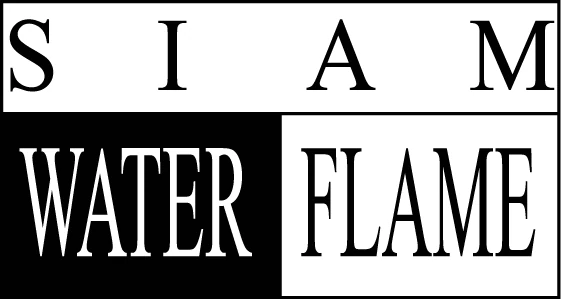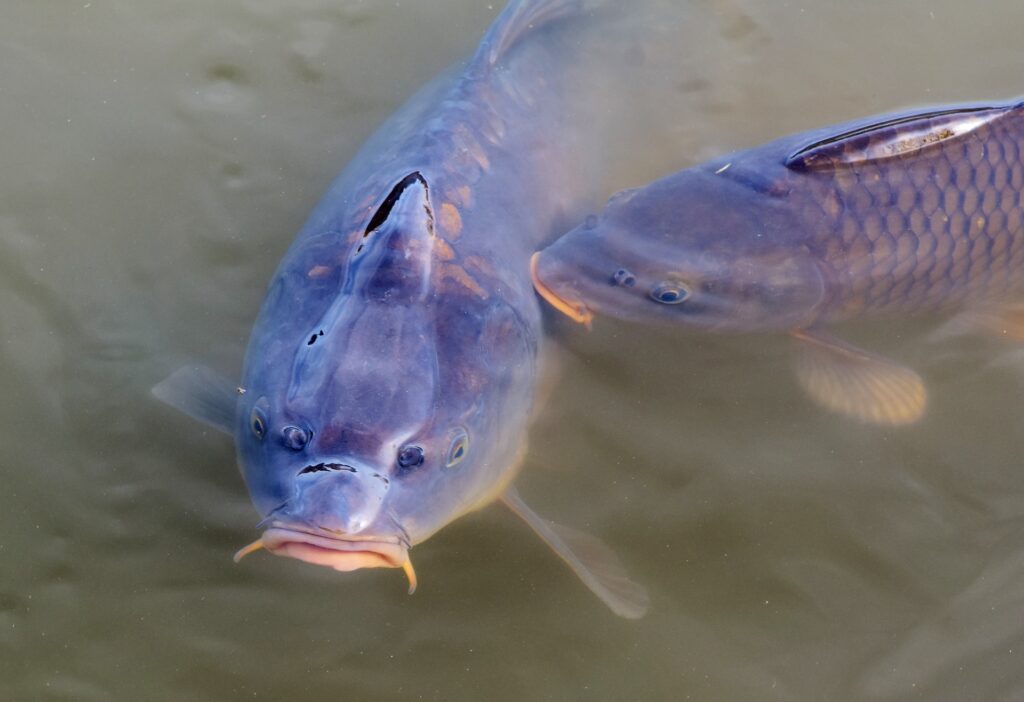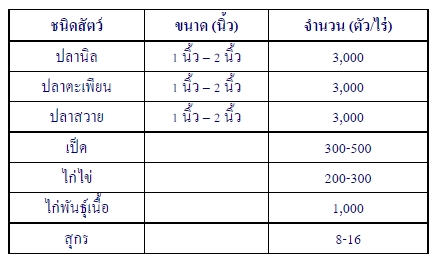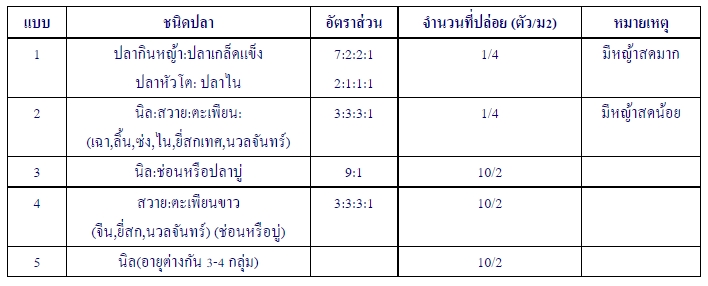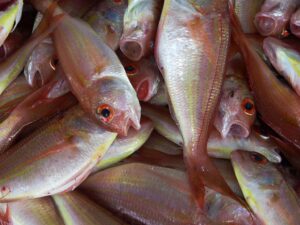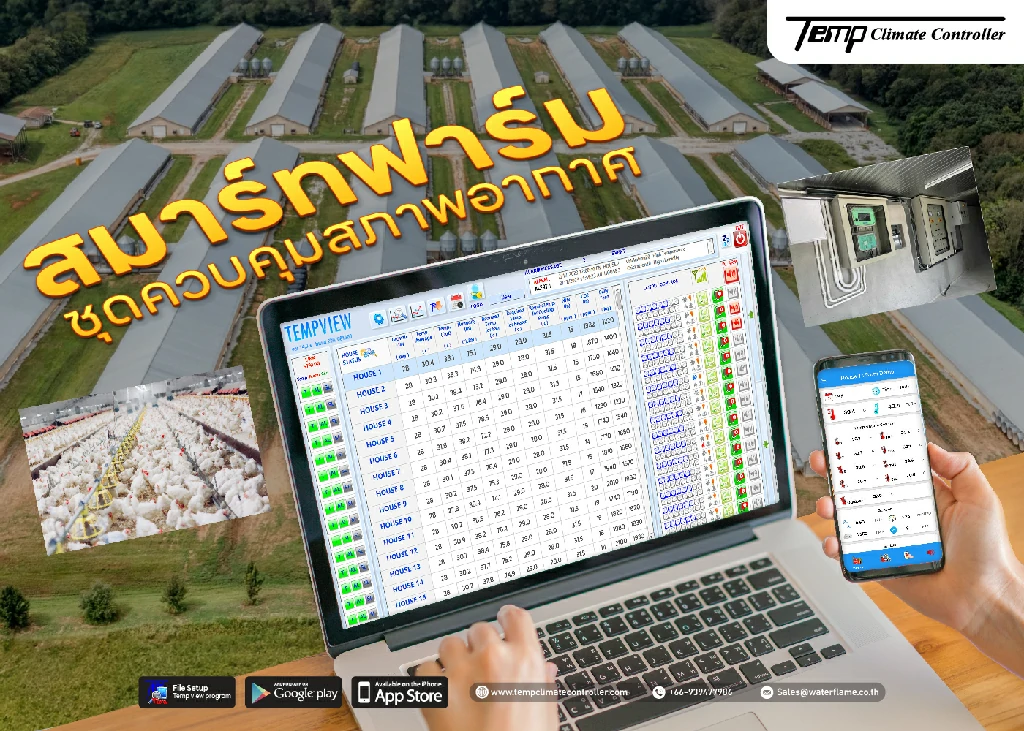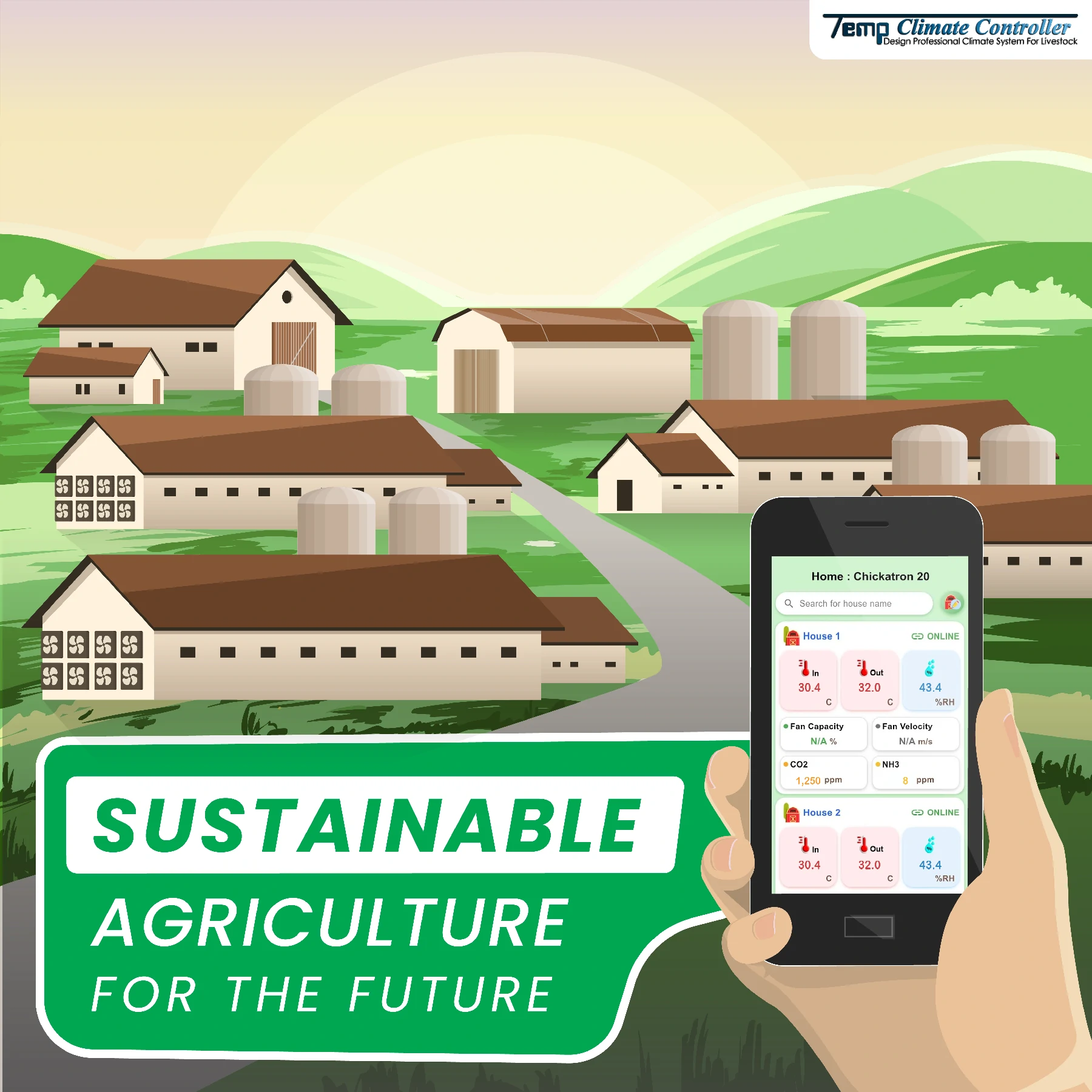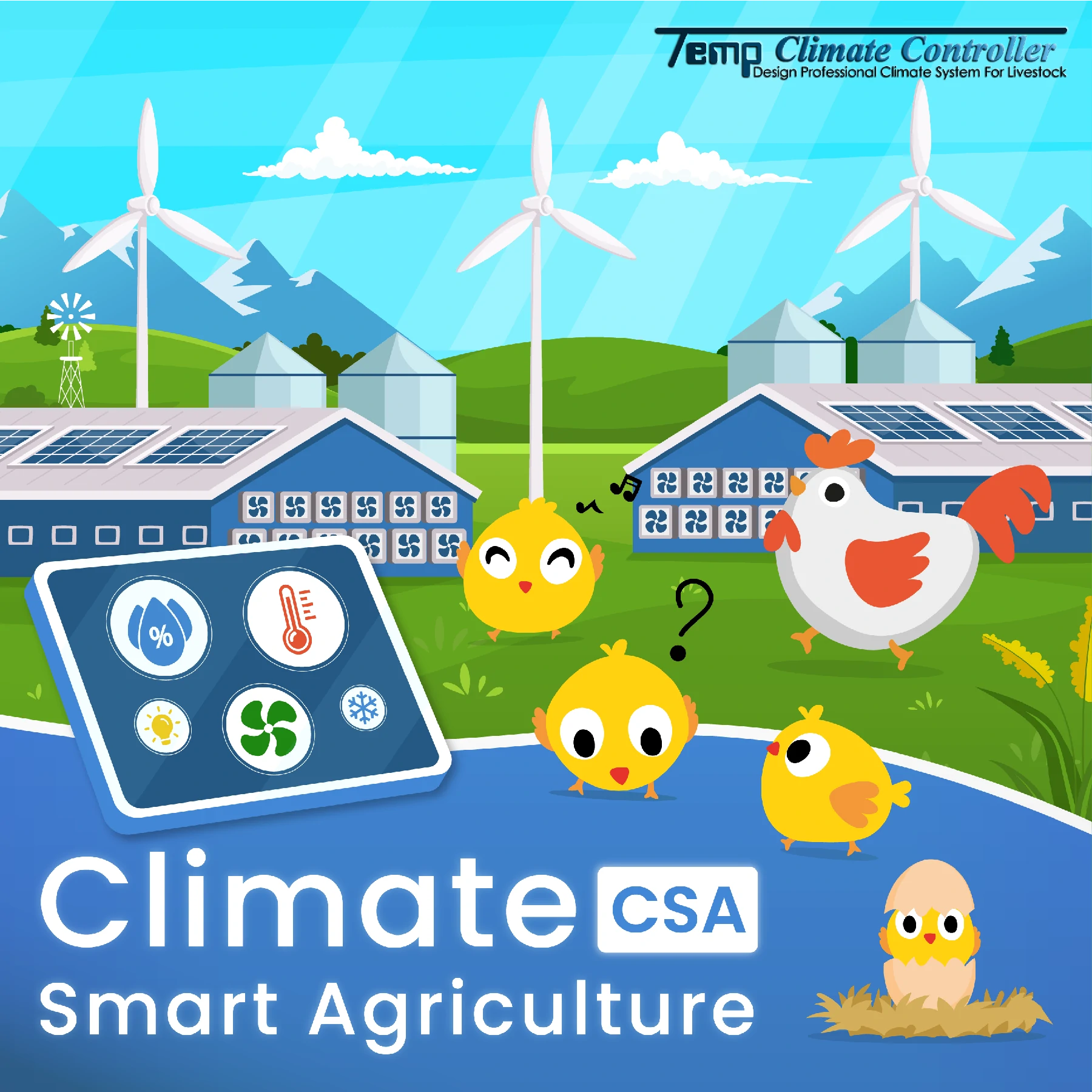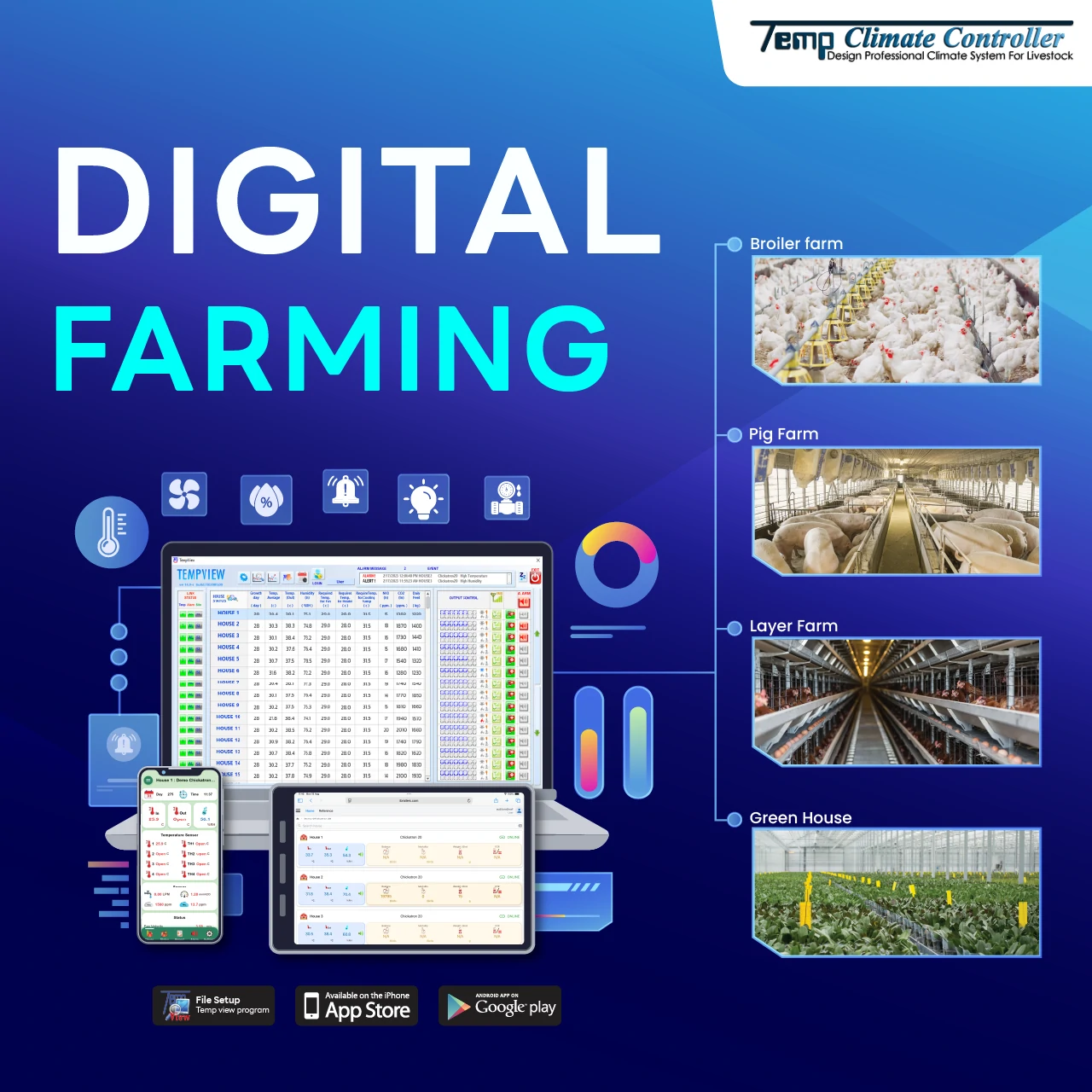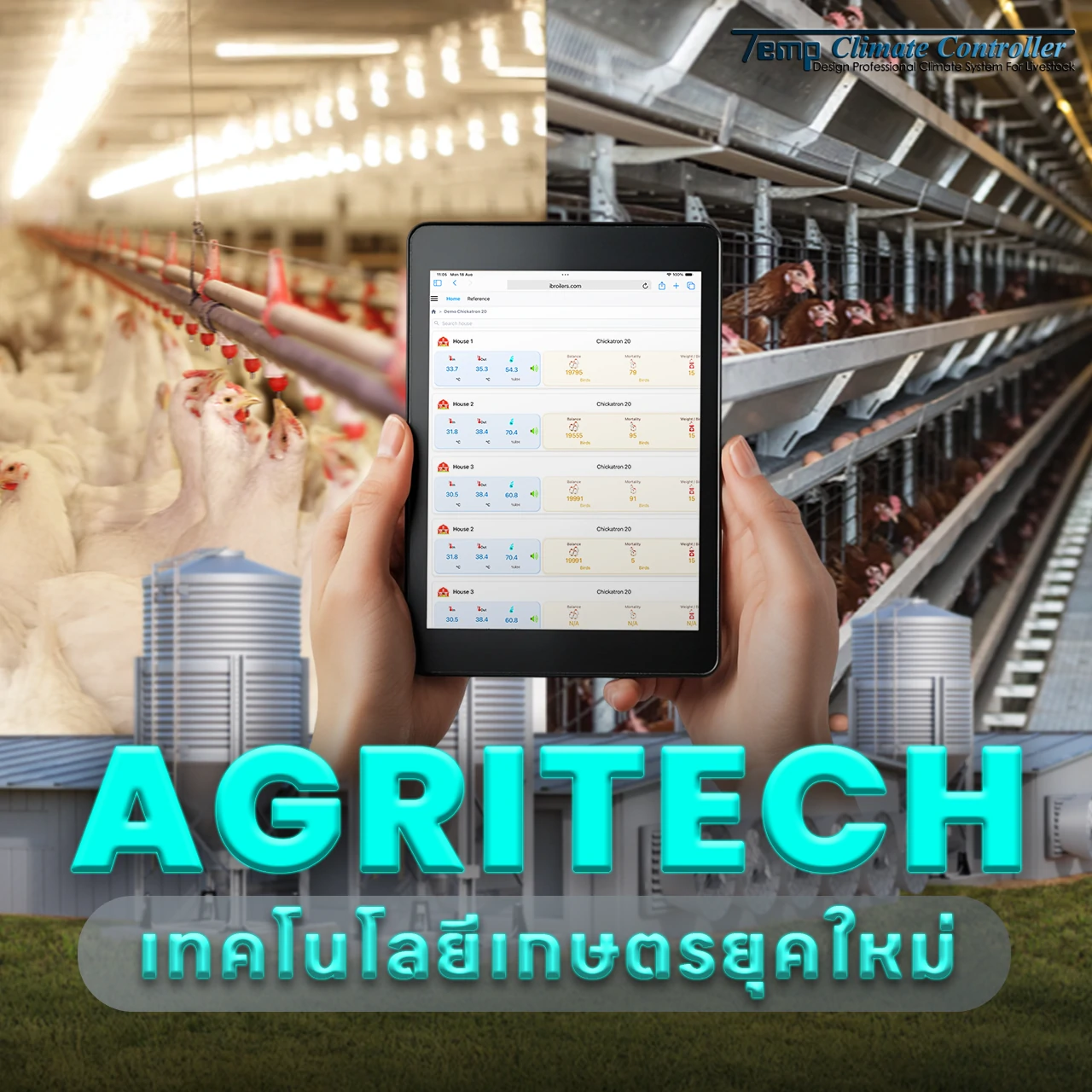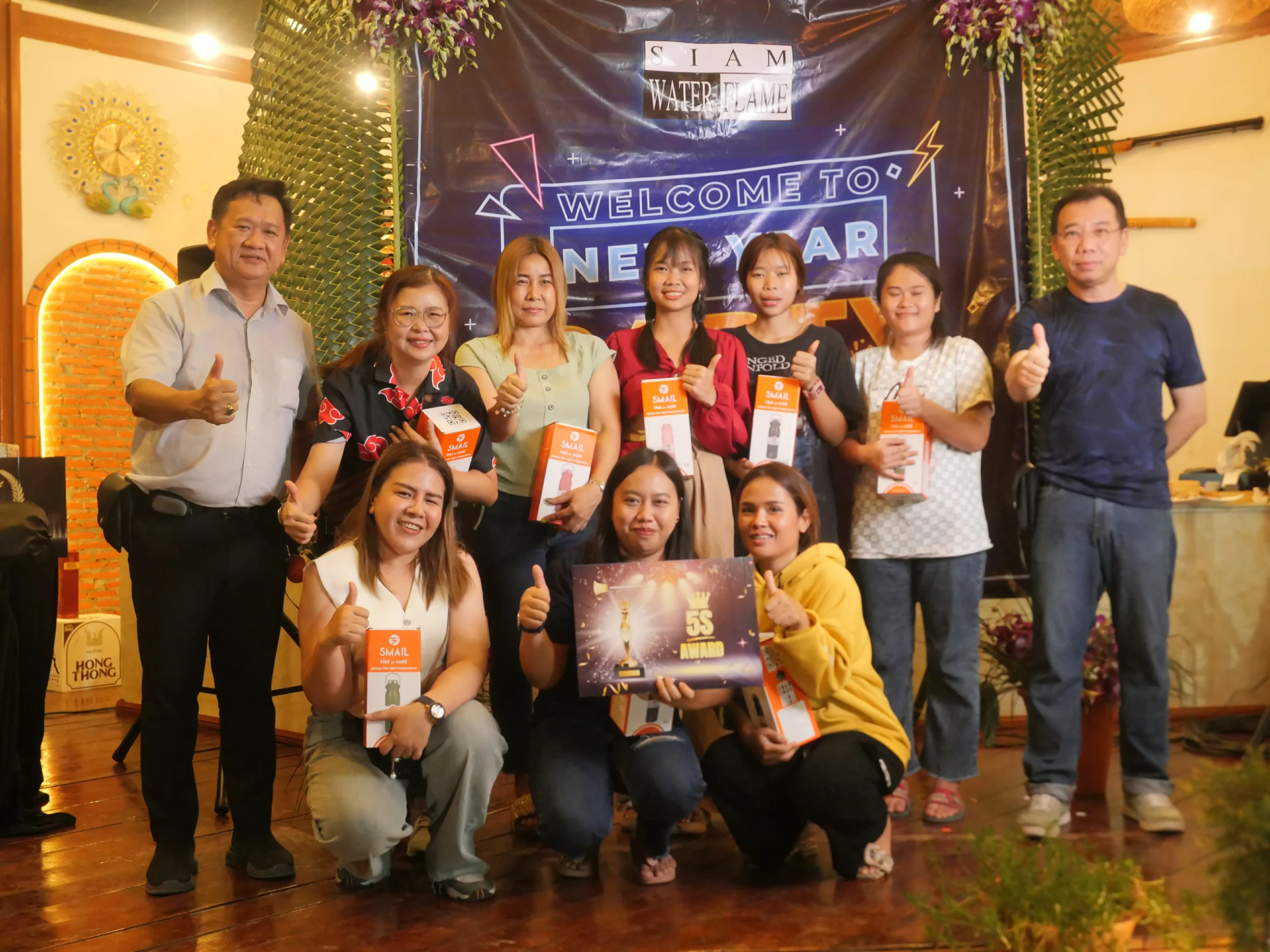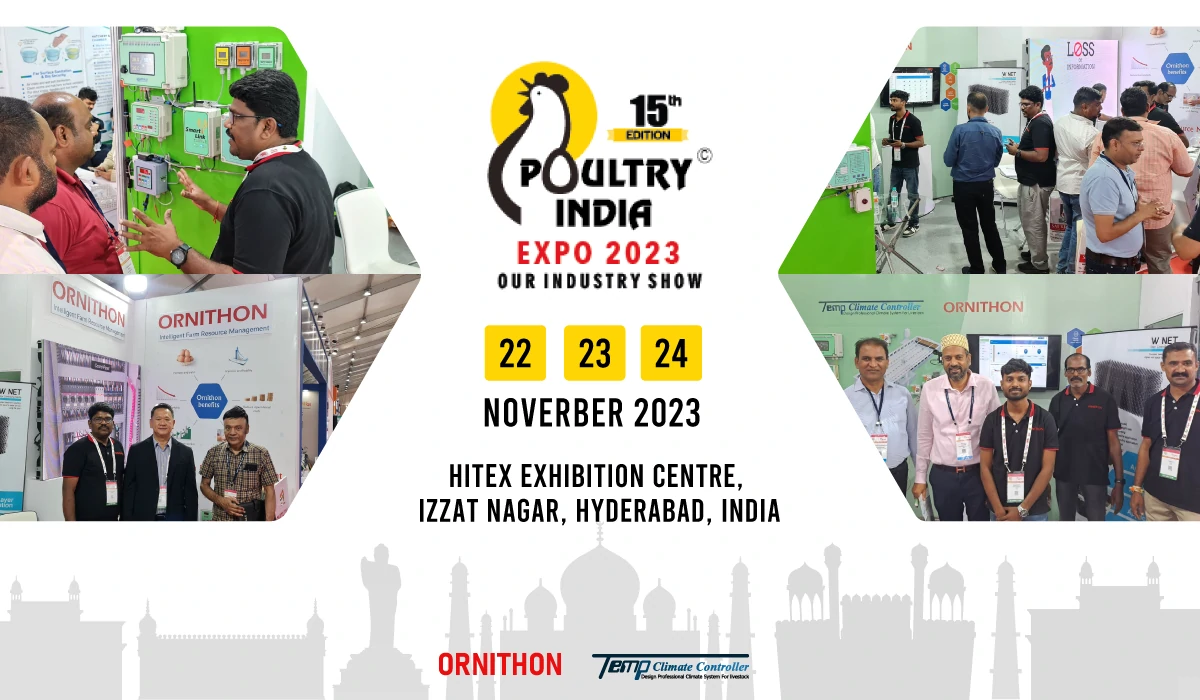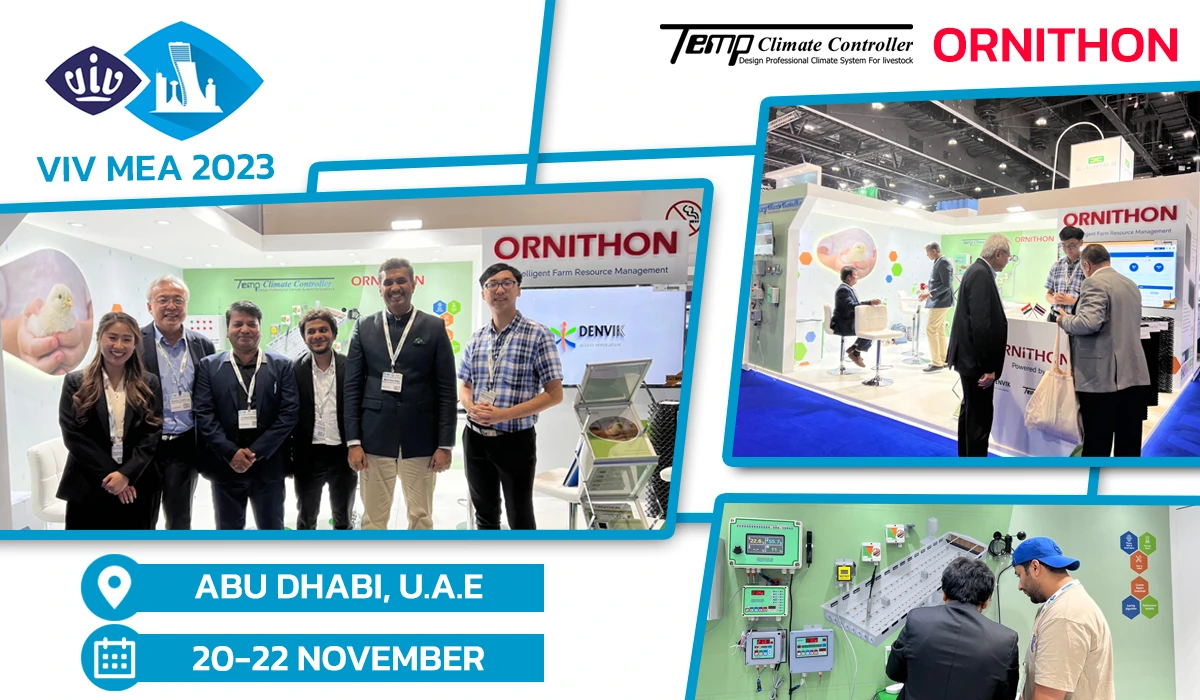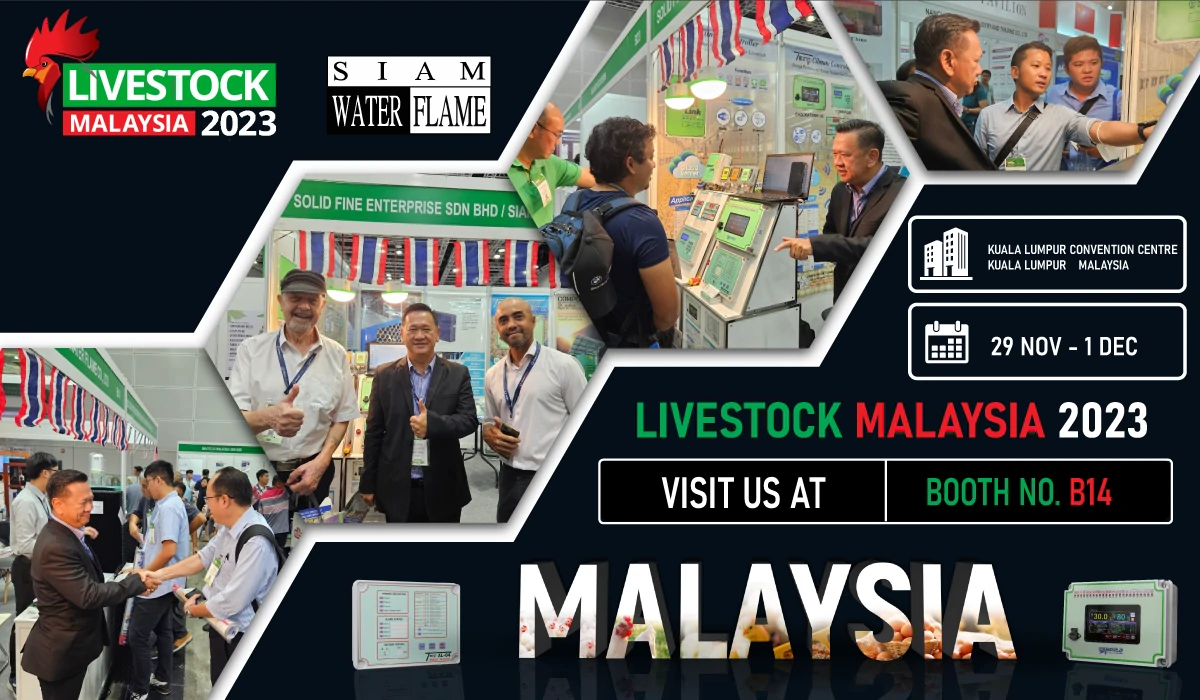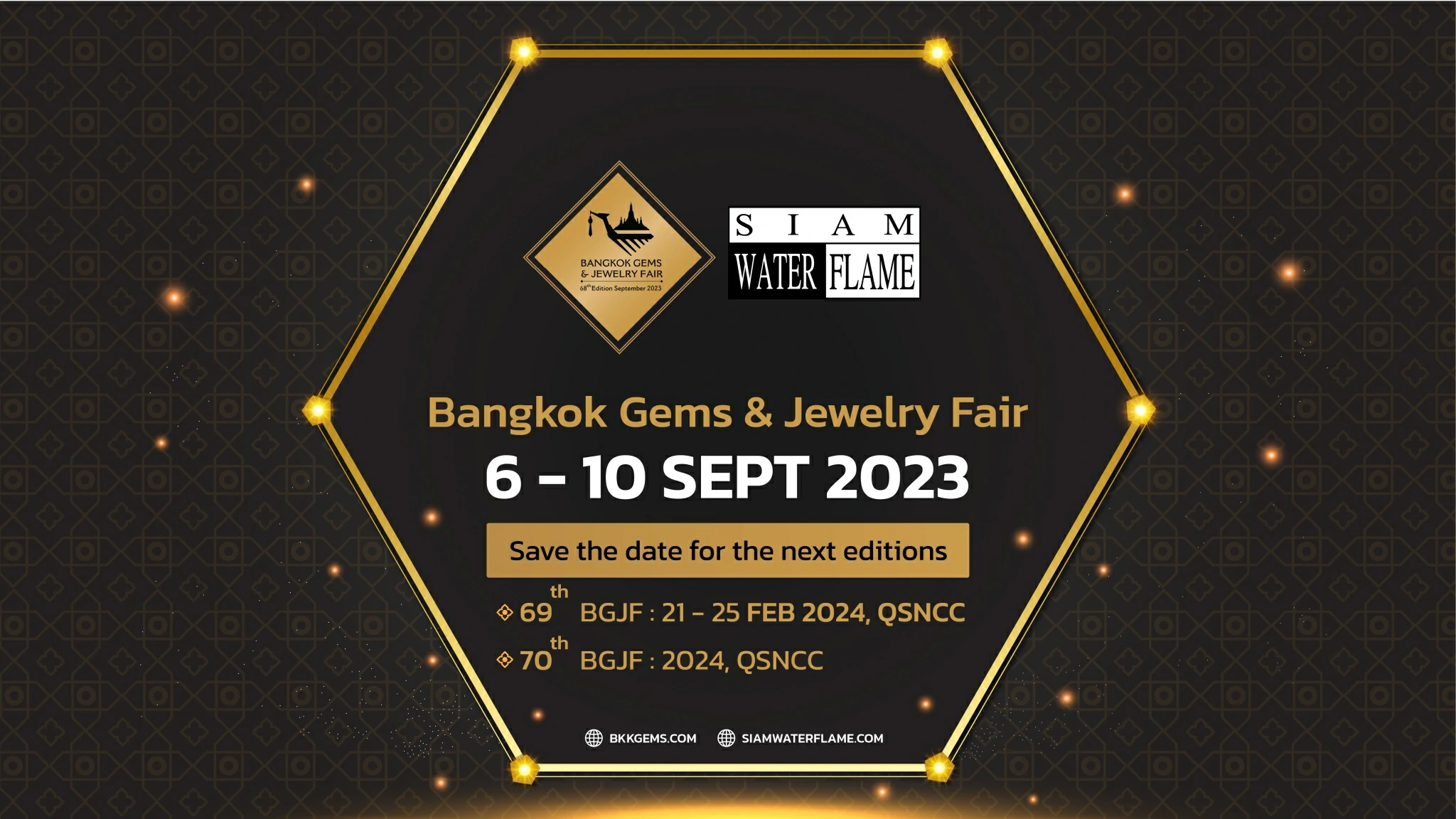Fish farming principles (หลักการเลี้ยงปลา )
rearing type
Fish farming in the pond
Fish farming in cement ponds
fish farming in cages
fish farming in rice fields
The most suitable type of farming at present is mixed fish farming. This is to make the most of the available space. can use each other as appropriate
fish farming in ponds
1) Location to build a pond = near a water source, clay soil Sticky, sandy, near the market, food raw materials, etc.
2) Pond preparation = pond drying / elimination of pests of fish that remain in the pond / lime application / use of manure (lime = 150 kg./rai + manure = 250-300 kg./rai)
3) Water preparation = water filter to protect the embryo. Eggs or other fish enemies, water level 1.5-1.8 meters, suitable water features.
4) Fish species release = Select fish species as appropriate for various conditions, source of raw materials market, expertise, etc. Release rate Should not be dense = 3,000-5,000 per/rai (herb-eating fish). The release rate will have an impact on management, growth, opportunities that should be in return, etc.
5) Management = Take into account the cost of production. with production planning
– Feeding appropriately as the fish want
– Providing food supplements to reduce costs
– Utilizing fish ponds to add value such as raising periwinkle in tandem, etc. Adding value through the processing of fish itself
– Combination in raising fish with plants and other animals such as pigs, chickens, ducks, buffaloes, etc.
Mixed fish farming
Integrated fish farming means raising fish together with animal husbandry. and planting crops in a particular area to make the most of the available land and water so that such activities can benefit each other
both directly and indirectly according to the appropriateness of the local environment To get more productivity and try to reduce production costs as much as possible. Including not causing negative effects on the environment and maintaining the productivity for a long time
Advantages of mixed fish farming
1. Can use the soil to the fullest. The soil around the pond is used for growing vegetables. and used to build stables As for the water in the pond, besides being used to raise fish, it can also be used to grow other crops such as morning glory.
2. Remnants of plants and animals can be recycled, such as animal manure, animal feed scraps. Vegetable scraps, which, if dropped into the pond, will become fish food and fertilizer for filling ponds. At the same time, the sludge from the bottom of the pond can be used to grow various crops well. Reusing the leftover waste to be used again eliminates waste and reduces expenses such as fish feed, animal feed, fertilizer.
3. To increase productivity and increase income can be used for family consumption If left, it can be sold as working capital for further proceedings. And it is the use of labor within the family to be useful.
4. Reduce the risk of loss better than raising fish, raising animals or planting only crops and reducing costs. because each activity has to depend on each other
5. Generate revolving income from selling fruits from farms throughout the year.
6. There is no negative impact on the ecology and production system. consumption – use The local resources are balanced, allowing the farming system to continue for as long as possible without problems. Therefore, it may be called one another. Sustainable Agriculture System
Mixed fish farming in combination with animal husbandry and plant cultivation
1. Fish farming together with planting
Due to the long-term fish farming, the pond will deteriorate from the mud. which is worthy of the rest of the food from the fish The mud in the pond is therefore fertile
that will benefit the plants and be able to return to the food for the fish. These mud fertilizers will increase the soil thickness of the crops. It helps to adjust the structure of soil components that absorb NPK and also make the soil better water absorbing.
2. Fish farming together with duck farming
Duck manure is a fertilizer which helps to increase biological productivity. And it adds natural food to fish or directly as food, that is, duck droppings produce phytoplankton and zooplankton as well as benthic
animals. Swimming and food use of ducks Helps increase oxygen in the water and help the nutrients in the soil spread Water soluble is useful in natural food production. Food and scraps used to feed ducks It is also fish food or some becomes fertilizer.
Fish species suitable for raising with ducks
It should be an omnivorous species. Or eat plankton such as tilapia, Nuan Nut and Song fish, mainly using tilapia. The hatchlings should be 5-7 cm in size, at the rate of 3,000 ducks/rai/240 duck eggs.
After raising pangasius for 2 months, the fish will be of sufficient size that it cannot be eaten as food. The food that will be used for raising is a mixture of 50% broken rice, 30% fine bran, 20% head meal.
3. Fish farming together with chicken farming
The purpose of farming is similar to raising fish with ducks. is to use manure as food for fish and as fertilizer to help create natural food to be used as food for another fried fish The daily excretion of chicken
droppings is approximately 24-106 kg/1,000 chickens. Should be an earthen pond that can hold water on average 1-1.50 meters during the raising with chickens.
The chicken coop should be built over the fish pond. for the benefit of space use and the use of chicken droppings or food scraps in fish farming directly Breeding chicks should begin after the pond has been prepared and the water is green.
This is to allow the chicken droppings to fall into the fish pond. The fry will continue to eat food. Should choose healthy fish that are similar in size. size of herbivorous fish And omnivorous should be 2 inches, and baby catfish should be 1 inch.
Fish breeds and ratios for raising fish with chickens
After the start of raising The amount of chicken manure released into the fish pond should be controlled to reduce water spoilage. Sucking water and sludge from the bottom of the pond after raising for a while then add water to the original level It will help the water conditions in the pond more suitable for the growth of fish.
4. Fish farming together with pig farming
Benefits of using pig manure in fish ponds Pig droppings will be the food of the catfish directly. Significantly reduce the production cost of pangasius, allowing more natural food for the fish. It helps to reduce the residual pig excrement that will cause the spread of germs and parasites. to humans and reared pigs
Raising 8-16 pigs is suitable for raising fish in a pond of 1 rai, depending on the type of fish. and the size of pigs raised in general When the pigs are small, a 1 rai fish pond will release 3,200 fish 3-5 cm. small pigs can increase the number. When the average weight of pigs is 50 kg, the ratio of 16 pigs is suitable for ponds of 1 rai in size. And pangasius because it is a fish that is resistant to the environment. and the properties of the water with the change of oxygen during the day and night
Fish breed and ratio of co-raising with pigs
5. Felling fish and raising cows
Cow manure is rich in minerals and has a slightly lower nutritional value than pig manure. Average number of aquatic plants and water mites that are natural food for fish The value of cow manure in the wells was higher than the unfertilized ponds. This allows omnivorous and plankton-eating fish to grow rapidly. This will reduce the cost of purchasing fertilizers and fish food as well as saving energy and protecting the environment.
Breeds of fish raised in ponds using cow dung should be divided into herbivorous fish such as cod, carp, etc. 10% are fed together with plankton-eating fish such as endemic fish, songfish. and many edible fish, such as carp 90%, with the rate of use of cow dung not more than 300-450 kg/rai/month.
releasing fish at a rate suitable for pets
Ratio and total number of fish released
The rate of use of different types of fertilizers in fish ponds
Problems and obstacles in the integrated fish farming
1. Most farmers still lack knowledge and understanding of proper fish raising, causing problems in waste water, fish are not growing fish disease due to various reasons such as releasing too much fish. The number of pets was not related to the pond and the number of fish. Lack of preventive and corrective measures when changing the condition of abbreviations and the number of fish, the use of pesticides, etc.
2. The determination of the sale of fish also depends on the middleman. As a result, the selling price is lower and the profit is less.
3. Lack of good quality fish breeding sources and there are enough numbers
Local ready-made aquatic food preparation
Farmers with small and medium sized farms with reasonable capital and have some knowledge of aquaculture feed Was able to produce ready-made aquatic feed for use by themselves.
in the form of wet and dry drowning pellets by using production tools that can be bought in the market which is very inexpensive As for floating food, it requires a high investment in purchasing a floating food processor especially. Because to make food float on water requires a very high heat and pressure system inside the machine. model food machine So normal can’t cook food floating on water. Here, we will talk about cooking drowning tablets only.
The process of preparing local ready-made aquatic animals has the following steps
Recipe
The first thing farmers will think of making ready-made meals for their own use is must know himself What recipes do you want to use to feed your own aquatic animals?
good recipes There are some observations as follows:
1. Make aquatic animals grow faster Strong and have good immunity
2. Make aquatic animals have a good meat exchange rate. and high survival rate
3. Various raw materials used can be purchased, readily available, cheap and easy to store. There are two ways for farmers to obtain good recipes:
1. Inquire from knowledgeable people And experience in aquatic feed, which is the fastest way. Government agencies, especially the Aquatic Feed Control and Development Division, the Department of Fisheries, can give advice on food recipes. Sample recipes for tilapia, catfish, herbivorous fish are included in further detail.
2. Self-learning and self-study, which this method is suitable for those who have high self-confidence, like to invent and find answers with their own experiences.
grinding
When the recipe is ready It must prepare to procure all the ingredients that will be needed according to the recipe and in sufficient quantity. To produce large raw materials, it has to go through the grinding
process. The purpose of grinding is to reduce the size of raw materials to a smaller size. which is beneficial for aquatic animals to be able to digest more easily Fine grinding also helps with pelletizing. By helping the food pellets have good stability. For the food grinder should be selected according to the type of raw materials. If using dry ingredients such as grits, soybean meal, corn,
then use a chopper or plate grinder. But if it is wet raw materials such as duck fish, chicken ribs, chicken intestines, chicken heads, use a fish grinder or meat grinder.
weighing
Once the various fine-grained ingredients have been prepared, they will be weighed according to the proportions of the recipe.
blending
It is the distribution of nutrition evenly in every part of the food that is made by combining several ingredients into a homogeneous one. Recommended mixers It should be a mixer that can mix both wet and dry ingredients. Such mixers are horizontal mixers. If you can’t find it, you can use a fish smoker or a meat grinder instead. Or you can mix it yourself by hand or with a shovel.
In the case of using dry raw materials, approximately 30-40 percent of the formula must be added with water and mixed well before pelletizing. But if using wet raw materials Mixing food does not require water at all or may add only a small amount of water. This depends on the estimated moisture content of all raw materials in the formula.
pelleting
This allows the mixed food to be extruded into strips or bars. The pelleting keeps the nutrients from all kinds of raw materials together. and less loss when exposed to water Pelletizing can be done using a fish mill or a meat grinder.
drying
This is the only necessary step for dry cooking. To reduce the humidity in the food and can be stored for a long time without mold. Drying can be done by spreading the food in a thin layer on a cement floor or sieve. Then use a fan or dry in the sun, the moisture in the food will evaporate. The resulting food will be dry drowning pellets.
Raw materials used in the finished aquaculture feed
Cooking ready-made aquatic animals for use within the farm must take into account the quality and price of the fish.
Food Good quality food should have complete nutrition and use high quality ingredients. which makes the aquatic animals digest well and non-toxic In addition, the price should not be so expensive that it makes production cost is too high
Aquatic animals need nutrients from about 40 types of food, including
1. Proteins and amino acids (There are about 10 essential amino acids in food.)
2. Essential substances that come from fat (fatty acids that are phospholipids and sterols)
3. Energy (proteins, fats and carbohydrates)
4. Vitamins (11 types of water soluble and 4 types of fat soluble)
5. Minerals (10 kinds)
Knowing what nutrients each species needs, it is imperative to provide them with the full range of nutrients.
These nutrients are obtained from raw materials used to make aquatic feed itself. There are many types of raw materials that differ in quality in terms of nutritional value. and digestibility Raw materials can be divided into five main categories:
1. Raw materials used as protein sources This type of raw material must have a favorite of more than 20%. It can be divided into 2 major sources:
1) Animal protein sources include fish meal, fresh fish meal, blood meal, bone meal, shrimp meal, chicken meal, chicken fillet, crabmeal, dairy products, etc.
2) Plant protein food sources include soybean meal, peanut meal, cottonseed, pressed coconut, sesame pulp, grape meal, acacia leaf meal, protein concentrate from corn, wheat, etc.
2. Raw materials used as energy sources
These raw materials are less than 20 percent protein but contain a lot of carhydrates or starches, including grains such as rice, corn, sorghum, wheat, oats and whole grain bran. The protein of these raw materials ranges from 8-12%, starch content is up to 60-80%, and fat is between 1-8%.
An interesting observation of this type of raw material is its properties as a food binder or as a sticky substance (byder).
3. Raw materials such as vitamins and minerals
The vitamins and minerals used in food ingredients are often in the form of chemical compounds and because they are used in very small quantities in recipes.
Thus causing problems in mixing thoroughly in every part, so it is not popular to mix vitamins. and individual minerals directly into the food Vitamins and minerals are therefore often pre-mixed with certain media, such as soybean meal, bran, rice husk, or limestone, and these mixtures are referred to as A “premix (premix)” is sometimes referred to as a “dietary
supplement.” This premix is then mixed with food. in some areas Farmers can’t find nine premixes used specifically for succulents. You can also use a pre-mixed premix to mix with pork or chicken feed instead. However, in pre-mixes used for terrestrial animals Often too high in vitamin D and may not contain vitamin C
in the ingredients Which vitamin C is very important for all kinds of aquatic animals. Therefore, it should be used as a primary consideration for purchasing.
4. Raw materials such as fats or oils
It is a raw material that provides energy. essential fatty acids Fat-soluble vitamins and resins were once used as pre-food additives. To stimulate the aquatic food to eat more crows. The oils used in animal feeds are divided into two main groups:
1) Animal oils such as fish oil, squid oil, lard, etc.
2) Vegetable oils such as soybean oil Corn oil, Palm oil, Peanut oil sunflower seed oil, etc.
5. Ingredients that enhance the quality of food
These ingredients are used in food. for purposes other than increasing the nutritional value of food Although sometimes used for enhancing purposes But it itself will be nutritious. These raw materials can be divided into 3 types as follows:
1) Sticky substances or byers or food binders
It is a substance that helps food to be durable in water for a long time. The use of glutinous substances is very important in cooking for slow-feeding aquatic animals
such as shrimp. Sticky substances can be divided into 3 main types: protein substances. carbohydrates and synthetic or natural substances that have no nutritional value
2) food flavoring agent
It is a substance that enhances the smell and taste of food to make it more appetizing. The odors in food that aquatic animals like are usually those that have their natural food. For example, carnivorous fish will like the smell of shrimp, shellfish, crab, fish, squid, etc. These odors can be obtained from scraps or processed products. then of such animals such as fish oil, oil, squid, head and shell of shrimp meal Squid crumbs, beef meal, etc.
3) Antioxidant
Food cravings are caused by chemical changes in the fat content of the food and moldy food is due to the moisture content of the food above 12%. In cooking, three chemicals are often added to prevent rancidity in that food: BHT and BHA, which are used in the amount of 0.2%. The most commonly used preservative is popionic acid. which is used in the amount of 0.3 %
Marketing techniques and future trends
Tilapia fishing, distribution and marketing
The timing of the sale is uncertain. It depends on the size of the tilapia and the market demand. In general, tilapia released into the same pond takes about 12 months to be caught and sold. Because the resulting tilapia weighs about 2-3 pieces per kilogram. which is the size required by the market As for the tilapia that are released to raise several generations in a single pond. The timing of the sale of fish depends on the price of the fish and the demand of the buyer. Tilapia can be caught in two ways:
1. Catch fish without a dry pond. They use distant nets to catch fish because they can get large fish as needed. hitting the fishing net The catchers stand in line in front of the board. And spaced about 4.50 meters,
which is on one side of the pond, then drag the nets to the other side of the pond along the length and lift the nets. After that, swing the fish into the basket to be weighed and sold. Keep doing this until the desired amount is achieved. As for the small fish, they will continue to be fed in the pond.
Each trawl will always have mixed fish as a by-product such as catfish, moray, carp, snakehead, etc.
Fish sizing can be done in two ways. which the Fish Bridge Organization will manage to select the size But if fish farmers sell them at the mouth of the pond, they need to sort the fish by themselves.
2. Catch fish in a dry pond Before catching a fish, the water must be pumped out of the pond to a minimum and the net is cast as in the first method. Until there were few left, they pumped water out of the pond once more and at the same time beat the water to drive the fish to gather in the trench. This trench is deep on one side of the
pond. When the water in the well is dry The fish will gather in the pond. And fish farmers continue to catch fish for sale. Most of these types of fishing are done every year in the dry season. to dry the ponds and start raising fish in the next production season
How to market tilapia
Characteristics and distribution of tilapia products
Tilapia farmers will sell their produce in many ways, including retail to various merchants who come to buy from the farm. which are either retailers in the market or merchants gathered in the area and from other localities or Delivered to the Fish
Bridge Organization for sale mainly, then the farmers will sell to the merchants who collect 66-71%, and sell to the wholesale merchants at the Fish Bridge Organization (21%), and 3-6 percent are sold in other forms.
price and movement
The price and production of tilapia are different in each locality. Rural markets are in demand for small tilapia for consumption. In contrast to urban markets, there is a large demand for fish, so fish prices are different.
the movement of prices that farmers can sell And the wholesale price is in the same direction. and depending on the season of fish sales Usually the selling price is high during January to September. The selling price at the farm is about 10 baht per kilogram of fish. The average retail price is 20-25 baht per kg. The difference between the farm price and the retail price is 10-15 baht per kg.
The export price depends mainly on the supply and demand of the world market. When competing countries such as Taiwan and Indonesia can produce a lot, Thailand will sell less. Because the production of frozen tilapia in the form of whole fish And the whole fish is gutted at a price that can’t compete with competitors’ countries.
However, the price of tilapia fillets is between 75-80 baht per kilogram. and for frozen tilapia The whole body is between 30-35 baht per kilogram.
Farmers’ tilapia marketing problems
Tilapia Market, a middleman determines the price and purchase volume. where the middlemen will buy to the farm because most farmers cannot bring their produce to sell at the market due to lack of equipment for handling and conveying They also have no knowledge of marketing. An important problem that determines the price that farmers always face is
1. Size of fish species Tilapia is an easy-breeding fish, capable of having children all year round. It is mostly female tilapia and the fry are small, not the weight that the buyer wants.
2. Muddy smell of fish meat Because the tilapia that is raised still uses food waste. material left over from consumption Or mix fish to make the fish fillets smell of mud.
3. Fish caught by farmers Most of the ponds and large numbers of dead fish were caught, transported and transported improperly. When processed, it is high in bacteria, giving the fish its green color.
4. Farmers lack funds. As a result, when the fish is large enough to be sold, farmers will immediately sell them, causing the price to be low.
Eliminating the smell
The smell is very common in cultured fish. Especially fish that are raised in ponds and are very problematic for export, such as the smell of rot or the smell of
mud. Originally understood that Moldy food may be the reason why the fish smells. But now it is known for certain that The smell of mud in the fish arises. Because fish absorb a solution in water called geosmin (geosmin)
into the gills. Or eat the culprit that produces this substance directly. and then accumulate emissions in the tissue that accumulates fat It is assumed that
the culprits that produce this substance include some blue-green algae, fungi and microorganisms that occur in the pond. These culprits often occur intensively in overfeeding ponds. Thus, if it is said that food is the cause of the smell of mud, it is because the amount of food used to feed it is not the quality of the food that directly causes it.
The smell of mud is not a permanent smell that stays with the fish forever. But this smell disappears when the fish sauce is placed in clean water and refrained from feeding for 7 days at a water temperature of 24 degrees Celsius. If the temperature is higher, the smell of mud will disappear from the fish faster. Soaking fish in clean water for 7 days can cause 5-12% weight loss of fish.
Tilapia doesn’t need W-6 fatty acids, which are abundant in fish oil, so fish oil should not be added to tilapia diets. Because besides having no benefit in providing essential fatty acids It can also cause fish to have a strong fishy smell even if they are kept for years.
Tilapia that has been fattened when it is carved will have a crumbly texture due to the accumulation of too much food fat in the meat. Usually, farmed fish have more fat than natural fish because they are fully fed to accelerate their growth. Foods that are high in fat or a high energy-to-protein ratio As a result, the quality of the meat is lower. On the other hand, if the fish has too little fat, which is caused by the fish being insufficiently fed. The fish will be too dry and hard to eat.
Domestic market
At present, domestic consumers became interested in consuming more tilapia And the Department of Fisheries has a project to promote the development of tilapia
farming. This will be an opportunity for consumers in Thailand to know more about the value of protein food from tilapia. The chances of domestic sales are likely to be good as well.
The vast majority of tilapia produce is consumed domestically, in fresh form, 89 percent, in processing, salting, 5% drying, 3% roasting, and the rest in other forms.
Whole and frozen tilapia are also available locally. The producer is the factory and sells it to restaurants or restaurants.
The future trend of tilapia farming
Tilapia is a fish that the consumer market is still in increasing demand due to the high population growth rate. This affects the trend of cultivating this species of fish to have a clear path. So you don’t have to worry about marketing problems because it’s a good-priced fish.
No barriers to the epidemic It is widely consumed and raised in all regions because it can be cooked in many
forms. especially At present, tilapia can be delivered as a commodity. Go out to foreign countries in the form of fish fillets, important markets such as Japan, the United States, Italy, etc. Therefore, raising quality tilapia Without the smell of mud would have a positive effect on consumption. Best selling and rewarding
Fish farming principles (หลักการเลี้ยงปลา )
rearing type
Fish farming in the pond
Fish farming in cement ponds
fish farming in cages
fish farming in rice fields
The most suitable type of farming at present is mixed fish farming. This is to make the most of the available space. can use each other as appropriate
fish farming in ponds
1) Location to build a pond = near a water source, clay soil Sticky, sandy, near the market, food raw materials, etc.
2) Pond preparation = pond drying / elimination of pests of fish that remain in the pond / lime application / use of manure (lime = 150 kg./rai + manure = 250-300 kg./rai)
3) Water preparation = water filter to protect the embryo. Eggs or other fish enemies, water level 1.5-1.8 meters, suitable water features.
4) Fish species release = Select fish species as appropriate for various conditions, source of raw materials market, expertise, etc. Release rate Should not be dense = 3,000-5,000 per/rai (herb-eating fish). The release rate will have an impact on management, growth, opportunities that should be in return, etc.
5) Management = Take into account the cost of production. with production planning
– Feeding appropriately as the fish want
– Providing food supplements to reduce costs
– Utilizing fish ponds to add value such as raising periwinkle in tandem, etc. Adding value through the processing of fish itself
– Combination in raising fish with plants and other animals such as pigs, chickens, ducks, buffaloes, etc.
Mixed fish farming
Integrated fish farming means raising fish together with animal husbandry. and planting crops in a particular area to make the most of the available land and water so that such activities can benefit each other
both directly and indirectly according to the appropriateness of the local environment To get more productivity and try to reduce production costs as much as possible. Including not causing negative effects on the environment and maintaining the productivity for a long time
Advantages of mixed fish farming
1. Can use the soil to the fullest. The soil around the pond is used for growing vegetables. and used to build stables As for the water in the pond, besides being used to raise fish, it can also be used to grow other crops such as morning glory.
2. Remnants of plants and animals can be recycled, such as animal manure, animal feed scraps. Vegetable scraps, which, if dropped into the pond, will become fish food and fertilizer for filling ponds. At the same time, the sludge from the bottom of the pond can be used to grow various crops well. Reusing the leftover waste to be used again eliminates waste and reduces expenses such as fish feed, animal feed, fertilizer.
3. To increase productivity and increase income can be used for family consumption If left, it can be sold as working capital for further proceedings. And it is the use of labor within the family to be useful.
4. Reduce the risk of loss better than raising fish, raising animals or planting only crops and reducing costs. because each activity has to depend on each other
5. Generate revolving income from selling fruits from farms throughout the year.
6. There is no negative impact on the ecology and production system. consumption – use The local resources are balanced, allowing the farming system to continue for as long as possible without problems. Therefore, it may be called one another. Sustainable Agriculture System
Mixed fish farming in combination with animal husbandry and plant cultivation
1. Fish farming together with planting
Due to the long-term fish farming, the pond will deteriorate from the mud. which is worthy of the rest of the food from the fish The mud in the pond is therefore fertile
that will benefit the plants and be able to return to the food for the fish. These mud fertilizers will increase the soil thickness of the crops. It helps to adjust the structure of soil components that absorb NPK and also make the soil better water absorbing.
2. Fish farming together with duck farming
Duck manure is a fertilizer which helps to increase biological productivity. And it adds natural food to fish or directly as food, that is, duck droppings produce phytoplankton and zooplankton as well as benthic
animals. Swimming and food use of ducks Helps increase oxygen in the water and help the nutrients in the soil spread Water soluble is useful in natural food production. Food and scraps used to feed ducks It is also fish food or some becomes fertilizer.
Fish species suitable for raising with ducks
It should be an omnivorous species. Or eat plankton such as tilapia, Nuan Nut and Song fish, mainly using tilapia. The hatchlings should be 5-7 cm in size, at the rate of 3,000 ducks/rai/240 duck eggs.
After raising pangasius for 2 months, the fish will be of sufficient size that it cannot be eaten as food. The food that will be used for raising is a mixture of 50% broken rice, 30% fine bran, 20% head meal.
3. Fish farming together with chicken farming
The purpose of farming is similar to raising fish with ducks. is to use manure as food for fish and as fertilizer to help create natural food to be used as food for another fried fish The daily excretion of chicken
droppings is approximately 24-106 kg/1,000 chickens. Should be an earthen pond that can hold water on average 1-1.50 meters during the raising with chickens.
The chicken coop should be built over the fish pond. for the benefit of space use and the use of chicken droppings or food scraps in fish farming directly Breeding chicks should begin after the pond has been prepared and the water is green.
This is to allow the chicken droppings to fall into the fish pond. The fry will continue to eat food. Should choose healthy fish that are similar in size. size of herbivorous fish And omnivorous should be 2 inches, and baby catfish should be 1 inch.
Fish breeds and ratios for raising fish with chickens
After the start of raising The amount of chicken manure released into the fish pond should be controlled to reduce water spoilage. Sucking water and sludge from the bottom of the pond after raising for a while then add water to the original level It will help the water conditions in the pond more suitable for the growth of fish.
4. Fish farming together with pig farming
Benefits of using pig manure in fish ponds Pig droppings will be the food of the catfish directly. Significantly reduce the production cost of pangasius, allowing more natural food for the fish. It helps to reduce the residual pig excrement that will cause the spread of germs and parasites. to humans and reared pigs
Raising 8-16 pigs is suitable for raising fish in a pond of 1 rai, depending on the type of fish. and the size of pigs raised in general When the pigs are small, a 1 rai fish pond will release 3,200 fish 3-5 cm. small pigs can increase the number. When the average weight of pigs is 50 kg, the ratio of 16 pigs is suitable for ponds of 1 rai in size. And pangasius because it is a fish that is resistant to the environment. and the properties of the water with the change of oxygen during the day and night
Fish breed and ratio of co-raising with pigs
5. Felling fish and raising cows
Cow manure is rich in minerals and has a slightly lower nutritional value than pig manure. Average number of aquatic plants and water mites that are natural food for fish The value of cow manure in the wells was higher than the unfertilized ponds. This allows omnivorous and plankton-eating fish to grow rapidly. This will reduce the cost of purchasing fertilizers and fish food as well as saving energy and protecting the environment.
Breeds of fish raised in ponds using cow dung should be divided into herbivorous fish such as cod, carp, etc. 10% are fed together with plankton-eating fish such as endemic fish, songfish. and many edible fish, such as carp 90%, with the rate of use of cow dung not more than 300-450 kg/rai/month.
releasing fish at a rate suitable for pets
Ratio and total number of fish released
The rate of use of different types of fertilizers in fish ponds
Problems and obstacles in the integrated fish farming
1. Most farmers still lack knowledge and understanding of proper fish raising, causing problems in waste water, fish are not growing fish disease due to various reasons such as releasing too much fish. The number of pets was not related to the pond and the number of fish. Lack of preventive and corrective measures when changing the condition of abbreviations and the number of fish, the use of pesticides, etc.
2. The determination of the sale of fish also depends on the middleman. As a result, the selling price is lower and the profit is less.
3. Lack of good quality fish breeding sources and there are enough numbers
Local ready-made aquatic food preparation
Farmers with small and medium sized farms with reasonable capital and have some knowledge of aquaculture feed Was able to produce ready-made aquatic feed for use by themselves.
in the form of wet and dry drowning pellets by using production tools that can be bought in the market which is very inexpensive As for floating food, it requires a high investment in purchasing a floating food processor especially. Because to make food float on water requires a very high heat and pressure system inside the machine. model food machine So normal can’t cook food floating on water. Here, we will talk about cooking drowning tablets only.
The process of preparing local ready-made aquatic animals has the following steps
Recipe
The first thing farmers will think of making ready-made meals for their own use is must know himself What recipes do you want to use to feed your own aquatic animals?
good recipes There are some observations as follows:
1. Make aquatic animals grow faster Strong and have good immunity
2. Make aquatic animals have a good meat exchange rate. and high survival rate
3. Various raw materials used can be purchased, readily available, cheap and easy to store. There are two ways for farmers to obtain good recipes:
1. Inquire from knowledgeable people And experience in aquatic feed, which is the fastest way. Government agencies, especially the Aquatic Feed Control and Development Division, the Department of Fisheries, can give advice on food recipes. Sample recipes for tilapia, catfish, herbivorous fish are included in further detail.
2. Self-learning and self-study, which this method is suitable for those who have high self-confidence, like to invent and find answers with their own experiences.
grinding
When the recipe is ready It must prepare to procure all the ingredients that will be needed according to the recipe and in sufficient quantity. To produce large raw materials, it has to go through the grinding
process. The purpose of grinding is to reduce the size of raw materials to a smaller size. which is beneficial for aquatic animals to be able to digest more easily Fine grinding also helps with pelletizing. By helping the food pellets have good stability. For the food grinder should be selected according to the type of raw materials. If using dry ingredients such as grits, soybean meal, corn,
then use a chopper or plate grinder. But if it is wet raw materials such as duck fish, chicken ribs, chicken intestines, chicken heads, use a fish grinder or meat grinder.
weighing
Once the various fine-grained ingredients have been prepared, they will be weighed according to the proportions of the recipe.
blending
It is the distribution of nutrition evenly in every part of the food that is made by combining several ingredients into a homogeneous one. Recommended mixers It should be a mixer that can mix both wet and dry ingredients. Such mixers are horizontal mixers. If you can’t find it, you can use a fish smoker or a meat grinder instead. Or you can mix it yourself by hand or with a shovel.
In the case of using dry raw materials, approximately 30-40 percent of the formula must be added with water and mixed well before pelletizing. But if using wet raw materials Mixing food does not require water at all or may add only a small amount of water. This depends on the estimated moisture content of all raw materials in the formula.
pelleting
This allows the mixed food to be extruded into strips or bars. The pelleting keeps the nutrients from all kinds of raw materials together. and less loss when exposed to water Pelletizing can be done using a fish mill or a meat grinder.
drying
This is the only necessary step for dry cooking. To reduce the humidity in the food and can be stored for a long time without mold. Drying can be done by spreading the food in a thin layer on a cement floor or sieve. Then use a fan or dry in the sun, the moisture in the food will evaporate. The resulting food will be dry drowning pellets.
Raw materials used in the finished aquaculture feed
Cooking ready-made aquatic animals for use within the farm must take into account the quality and price of the fish.
Food Good quality food should have complete nutrition and use high quality ingredients. which makes the aquatic animals digest well and non-toxic In addition, the price should not be so expensive that it makes production cost is too high
Aquatic animals need nutrients from about 40 types of food, including
1. Proteins and amino acids (There are about 10 essential amino acids in food.)
2. Essential substances that come from fat (fatty acids that are phospholipids and sterols)
3. Energy (proteins, fats and carbohydrates)
4. Vitamins (11 types of water soluble and 4 types of fat soluble)
5. Minerals (10 kinds)
Knowing what nutrients each species needs, it is imperative to provide them with the full range of nutrients.
These nutrients are obtained from raw materials used to make aquatic feed itself. There are many types of raw materials that differ in quality in terms of nutritional value. and digestibility Raw materials can be divided into five main categories:
1. Raw materials used as protein sources This type of raw material must have a favorite of more than 20%. It can be divided into 2 major sources:
1) Animal protein sources include fish meal, fresh fish meal, blood meal, bone meal, shrimp meal, chicken meal, chicken fillet, crabmeal, dairy products, etc.
2) Plant protein food sources include soybean meal, peanut meal, cottonseed, pressed coconut, sesame pulp, grape meal, acacia leaf meal, protein concentrate from corn, wheat, etc.
2. Raw materials used as energy sources
These raw materials are less than 20 percent protein but contain a lot of carhydrates or starches, including grains such as rice, corn, sorghum, wheat, oats and whole grain bran. The protein of these raw materials ranges from 8-12%, starch content is up to 60-80%, and fat is between 1-8%.
An interesting observation of this type of raw material is its properties as a food binder or as a sticky substance (byder).
3. Raw materials such as vitamins and minerals
The vitamins and minerals used in food ingredients are often in the form of chemical compounds and because they are used in very small quantities in recipes.
Thus causing problems in mixing thoroughly in every part, so it is not popular to mix vitamins. and individual minerals directly into the food Vitamins and minerals are therefore often pre-mixed with certain media, such as soybean meal, bran, rice husk, or limestone, and these mixtures are referred to as A “premix (premix)” is sometimes referred to as a “dietary
supplement.” This premix is then mixed with food. in some areas Farmers can’t find nine premixes used specifically for succulents. You can also use a pre-mixed premix to mix with pork or chicken feed instead. However, in pre-mixes used for terrestrial animals Often too high in vitamin D and may not contain vitamin C
in the ingredients Which vitamin C is very important for all kinds of aquatic animals. Therefore, it should be used as a primary consideration for purchasing.
4. Raw materials such as fats or oils
It is a raw material that provides energy. essential fatty acids Fat-soluble vitamins and resins were once used as pre-food additives. To stimulate the aquatic food to eat more crows. The oils used in animal feeds are divided into two main groups:
1) Animal oils such as fish oil, squid oil, lard, etc.
2) Vegetable oils such as soybean oil Corn oil, Palm oil, Peanut oil sunflower seed oil, etc.
5. Ingredients that enhance the quality of food
These ingredients are used in food. for purposes other than increasing the nutritional value of food Although sometimes used for enhancing purposes But it itself will be nutritious. These raw materials can be divided into 3 types as follows:
1) Sticky substances or byers or food binders
It is a substance that helps food to be durable in water for a long time. The use of glutinous substances is very important in cooking for slow-feeding aquatic animals
such as shrimp. Sticky substances can be divided into 3 main types: protein substances. carbohydrates and synthetic or natural substances that have no nutritional value
2) food flavoring agent
It is a substance that enhances the smell and taste of food to make it more appetizing. The odors in food that aquatic animals like are usually those that have their natural food. For example, carnivorous fish will like the smell of shrimp, shellfish, crab, fish, squid, etc. These odors can be obtained from scraps or processed products. then of such animals such as fish oil, oil, squid, head and shell of shrimp meal Squid crumbs, beef meal, etc.
3) Antioxidant
Food cravings are caused by chemical changes in the fat content of the food and moldy food is due to the moisture content of the food above 12%. In cooking, three chemicals are often added to prevent rancidity in that food: BHT and BHA, which are used in the amount of 0.2%. The most commonly used preservative is popionic acid. which is used in the amount of 0.3 %
Marketing techniques and future trends
Tilapia fishing, distribution and marketing
The timing of the sale is uncertain. It depends on the size of the tilapia and the market demand. In general, tilapia released into the same pond takes about 12 months to be caught and sold. Because the resulting tilapia weighs about 2-3 pieces per kilogram. which is the size required by the market As for the tilapia that are released to raise several generations in a single pond. The timing of the sale of fish depends on the price of the fish and the demand of the buyer. Tilapia can be caught in two ways:
1. Catch fish without a dry pond. They use distant nets to catch fish because they can get large fish as needed. hitting the fishing net The catchers stand in line in front of the board. And spaced about 4.50 meters,
which is on one side of the pond, then drag the nets to the other side of the pond along the length and lift the nets. After that, swing the fish into the basket to be weighed and sold. Keep doing this until the desired amount is achieved. As for the small fish, they will continue to be fed in the pond.
Each trawl will always have mixed fish as a by-product such as catfish, moray, carp, snakehead, etc.
Fish sizing can be done in two ways. which the Fish Bridge Organization will manage to select the size But if fish farmers sell them at the mouth of the pond, they need to sort the fish by themselves.
2. Catch fish in a dry pond Before catching a fish, the water must be pumped out of the pond to a minimum and the net is cast as in the first method. Until there were few left, they pumped water out of the pond once more and at the same time beat the water to drive the fish to gather in the trench. This trench is deep on one side of the
pond. When the water in the well is dry The fish will gather in the pond. And fish farmers continue to catch fish for sale. Most of these types of fishing are done every year in the dry season. to dry the ponds and start raising fish in the next production season
How to market tilapia
Characteristics and distribution of tilapia products
Tilapia farmers will sell their produce in many ways, including retail to various merchants who come to buy from the farm. which are either retailers in the market or merchants gathered in the area and from other localities or Delivered to the Fish
Bridge Organization for sale mainly, then the farmers will sell to the merchants who collect 66-71%, and sell to the wholesale merchants at the Fish Bridge Organization (21%), and 3-6 percent are sold in other forms.
price and movement
The price and production of tilapia are different in each locality. Rural markets are in demand for small tilapia for consumption. In contrast to urban markets, there is a large demand for fish, so fish prices are different.
the movement of prices that farmers can sell And the wholesale price is in the same direction. and depending on the season of fish sales Usually the selling price is high during January to September. The selling price at the farm is about 10 baht per kilogram of fish. The average retail price is 20-25 baht per kg. The difference between the farm price and the retail price is 10-15 baht per kg.
The export price depends mainly on the supply and demand of the world market. When competing countries such as Taiwan and Indonesia can produce a lot, Thailand will sell less. Because the production of frozen tilapia in the form of whole fish And the whole fish is gutted at a price that can’t compete with competitors’ countries.
However, the price of tilapia fillets is between 75-80 baht per kilogram. and for frozen tilapia The whole body is between 30-35 baht per kilogram.
Farmers’ tilapia marketing problems
Tilapia Market, a middleman determines the price and purchase volume. where the middlemen will buy to the farm because most farmers cannot bring their produce to sell at the market due to lack of equipment for handling and conveying They also have no knowledge of marketing. An important problem that determines the price that farmers always face is
1. Size of fish species Tilapia is an easy-breeding fish, capable of having children all year round. It is mostly female tilapia and the fry are small, not the weight that the buyer wants.
2. Muddy smell of fish meat Because the tilapia that is raised still uses food waste. material left over from consumption Or mix fish to make the fish fillets smell of mud.
3. Fish caught by farmers Most of the ponds and large numbers of dead fish were caught, transported and transported improperly. When processed, it is high in bacteria, giving the fish its green color.
4. Farmers lack funds. As a result, when the fish is large enough to be sold, farmers will immediately sell them, causing the price to be low.
Eliminating the smell
The smell is very common in cultured fish. Especially fish that are raised in ponds and are very problematic for export, such as the smell of rot or the smell of
mud. Originally understood that Moldy food may be the reason why the fish smells. But now it is known for certain that The smell of mud in the fish arises. Because fish absorb a solution in water called geosmin (geosmin)
into the gills. Or eat the culprit that produces this substance directly. and then accumulate emissions in the tissue that accumulates fat It is assumed that
the culprits that produce this substance include some blue-green algae, fungi and microorganisms that occur in the pond. These culprits often occur intensively in overfeeding ponds. Thus, if it is said that food is the cause of the smell of mud, it is because the amount of food used to feed it is not the quality of the food that directly causes it.
The smell of mud is not a permanent smell that stays with the fish forever. But this smell disappears when the fish sauce is placed in clean water and refrained from feeding for 7 days at a water temperature of 24 degrees Celsius. If the temperature is higher, the smell of mud will disappear from the fish faster. Soaking fish in clean water for 7 days can cause 5-12% weight loss of fish.
Tilapia doesn’t need W-6 fatty acids, which are abundant in fish oil, so fish oil should not be added to tilapia diets. Because besides having no benefit in providing essential fatty acids It can also cause fish to have a strong fishy smell even if they are kept for years.
Tilapia that has been fattened when it is carved will have a crumbly texture due to the accumulation of too much food fat in the meat. Usually, farmed fish have more fat than natural fish because they are fully fed to accelerate their growth. Foods that are high in fat or a high energy-to-protein ratio As a result, the quality of the meat is lower. On the other hand, if the fish has too little fat, which is caused by the fish being insufficiently fed. The fish will be too dry and hard to eat.
Domestic market
At present, domestic consumers became interested in consuming more tilapia And the Department of Fisheries has a project to promote the development of tilapia
farming. This will be an opportunity for consumers in Thailand to know more about the value of protein food from tilapia. The chances of domestic sales are likely to be good as well.
The vast majority of tilapia produce is consumed domestically, in fresh form, 89 percent, in processing, salting, 5% drying, 3% roasting, and the rest in other forms.
Whole and frozen tilapia are also available locally. The producer is the factory and sells it to restaurants or restaurants.
The future trend of tilapia farming
Tilapia is a fish that the consumer market is still in increasing demand due to the high population growth rate. This affects the trend of cultivating this species of fish to have a clear path. So you don’t have to worry about marketing problems because it’s a good-priced fish.
No barriers to the epidemic It is widely consumed and raised in all regions because it can be cooked in many
forms. especially At present, tilapia can be delivered as a commodity. Go out to foreign countries in the form of fish fillets, important markets such as Japan, the United States, Italy, etc. Therefore, raising quality tilapia Without the smell of mud would have a positive effect on consumption. Best selling and rewarding
fish farming principles (หลักการเลี้ยงปลา )
rearing type
Fish farming in the pond
Fish farming in cement ponds
fish farming in cages
fish farming in rice fields
The most suitable type of farming at present is mixed fish farming. This is to make the most of the available space. can use each other as appropriate
fish farming in ponds
1) Location to build a pond = near a water source, clay soil Sticky, sandy, near the market, food raw materials, etc.
2) Pond preparation = pond drying / elimination of pests of fish that remain in the pond / lime application / use of manure (lime = 150 kg./rai + manure = 250-300 kg./rai)
3) Water preparation = water filter to protect the embryo. Eggs or other fish enemies, water level 1.5-1.8 meters, suitable water features.
4) Fish species release = Select fish species as appropriate for various conditions, source of raw materials market, expertise, etc. Release rate Should not be dense = 3,000-5,000 per/rai (herb-eating fish). The release rate will have an impact on management, growth, opportunities that should be in return, etc.
5) Management = Take into account the cost of production. with production planning
– Feeding appropriately as the fish want
– Providing food supplements to reduce costs
– Utilizing fish ponds to add value such as raising periwinkle in tandem, etc. Adding value through the processing of fish itself
– Combination in raising fish with plants and other animals such as pigs, chickens, ducks, buffaloes, etc.
Mixed fish farming
Integrated fish farming means raising fish together with animal husbandry. and planting crops in a particular area to make the most of the available land and water so that such activities can benefit each other
both directly and indirectly according to the appropriateness of the local environment To get more productivity and try to reduce production costs as much as possible. Including not causing negative effects on the environment and maintaining the productivity for a long time
Advantages of mixed fish farming
1. Can use the soil to the fullest. The soil around the pond is used for growing vegetables. and used to build stables As for the water in the pond, besides being used to raise fish, it can also be used to grow other crops such as morning glory.
2. Remnants of plants and animals can be recycled, such as animal manure, animal feed scraps. Vegetable scraps, which, if dropped into the pond, will become fish food and fertilizer for filling ponds. At the same time, the sludge from the bottom of the pond can be used to grow various crops well. Reusing the leftover waste to be used again eliminates waste and reduces expenses such as fish feed, animal feed, fertilizer.
3. To increase productivity and increase income can be used for family consumption If left, it can be sold as working capital for further proceedings. And it is the use of labor within the family to be useful.
4. Reduce the risk of loss better than raising fish, raising animals or planting only crops and reducing costs. because each activity has to depend on each other
5. Generate revolving income from selling fruits from farms throughout the year.
6. There is no negative impact on the ecology and production system. consumption – use The local resources are balanced, allowing the farming system to continue for as long as possible without problems. Therefore, it may be called one another. Sustainable Agriculture System
Mixed fish farming in combination with animal husbandry and plant cultivation
1. Fish farming together with planting
Due to the long-term fish farming, the pond will deteriorate from the mud. which is worthy of the rest of the food from the fish The mud in the pond is therefore fertile
that will benefit the plants and be able to return to the food for the fish. These mud fertilizers will increase the soil thickness of the crops. It helps to adjust the structure of soil components that absorb NPK and also make the soil better water absorbing.
2. Fish farming together with duck farming
Duck manure is a fertilizer which helps to increase biological productivity. And it adds natural food to fish or directly as food, that is, duck droppings produce phytoplankton and zooplankton as well as benthic
animals. Swimming and food use of ducks Helps increase oxygen in the water and help the nutrients in the soil spread Water soluble is useful in natural food production. Food and scraps used to feed ducks It is also fish food or some becomes fertilizer.
Fish species suitable for raising with ducks
It should be an omnivorous species. Or eat plankton such as tilapia, Nuan Nut and Song fish, mainly using tilapia. The hatchlings should be 5-7 cm in size, at the rate of 3,000 ducks/rai/240 duck eggs.
After raising pangasius for 2 months, the fish will be of sufficient size that it cannot be eaten as food. The food that will be used for raising is a mixture of 50% broken rice, 30% fine bran, 20% head meal.
3. Fish farming together with chicken farming
The purpose of farming is similar to raising fish with ducks. is to use manure as food for fish and as fertilizer to help create natural food to be used as food for another fried fish The daily excretion of chicken
droppings is approximately 24-106 kg/1,000 chickens. Should be an earthen pond that can hold water on average 1-1.50 meters during the raising with chickens.
The chicken coop should be built over the fish pond. for the benefit of space use and the use of chicken droppings or food scraps in fish farming directly Breeding chicks should begin after the pond has been prepared and the water is green.
This is to allow the chicken droppings to fall into the fish pond. The fry will continue to eat food. Should choose healthy fish that are similar in size. size of herbivorous fish And omnivorous should be 2 inches, and baby catfish should be 1 inch.
Fish breeds and ratios for raising fish with chickens
After the start of raising The amount of chicken manure released into the fish pond should be controlled to reduce water spoilage. Sucking water and sludge from the bottom of the pond after raising for a while then add water to the original level It will help the water conditions in the pond more suitable for the growth of fish.
4. Fish farming together with pig farming
Benefits of using pig manure in fish ponds Pig droppings will be the food of the catfish directly. Significantly reduce the production cost of pangasius, allowing more natural food for the fish. It helps to reduce the residual pig excrement that will cause the spread of germs and parasites. to humans and reared pigs
Raising 8-16 pigs is suitable for raising fish in a pond of 1 rai, depending on the type of fish. and the size of pigs raised in general When the pigs are small, a 1 rai fish pond will release 3,200 fish 3-5 cm. small pigs can increase the number. When the average weight of pigs is 50 kg, the ratio of 16 pigs is suitable for ponds of 1 rai in size. And pangasius because it is a fish that is resistant to the environment. and the properties of the water with the change of oxygen during the day and night
Fish breed and ratio of co-raising with pigs
5. Felling fish and raising cows
Cow manure is rich in minerals and has a slightly lower nutritional value than pig manure. Average number of aquatic plants and water mites that are natural food for fish The value of cow manure in the wells was higher than the unfertilized ponds. This allows omnivorous and plankton-eating fish to grow rapidly. This will reduce the cost of purchasing fertilizers and fish food as well as saving energy and protecting the environment.
Breeds of fish raised in ponds using cow dung should be divided into herbivorous fish such as cod, carp, etc. 10% are fed together with plankton-eating fish such as endemic fish, songfish. and many edible fish, such as carp 90%, with the rate of use of cow dung not more than 300-450 kg/rai/month.
releasing fish at a rate suitable for pets
Ratio and total number of fish released
The rate of use of different types of fertilizers in fish ponds
Problems and obstacles in the integrated fish farming
1. Most farmers still lack knowledge and understanding of proper fish raising, causing problems in waste water, fish are not growing fish disease due to various reasons such as releasing too much fish. The number of pets was not related to the pond and the number of fish. Lack of preventive and corrective measures when changing the condition of abbreviations and the number of fish, the use of pesticides, etc.
2. The determination of the sale of fish also depends on the middleman. As a result, the selling price is lower and the profit is less.
3. Lack of good quality fish breeding sources and there are enough numbers
Local ready-made aquatic food preparation
Farmers with small and medium sized farms with reasonable capital and have some knowledge of aquaculture feed Was able to produce ready-made aquatic feed for use by themselves.
in the form of wet and dry drowning pellets by using production tools that can be bought in the market which is very inexpensive As for floating food, it requires a high investment in purchasing a floating food processor especially. Because to make food float on water requires a very high heat and pressure system inside the machine. model food machine So normal can’t cook food floating on water. Here, we will talk about cooking drowning tablets only.
The process of preparing local ready-made aquatic animals has the following steps
Recipe
The first thing farmers will think of making ready-made meals for their own use is must know himself What recipes do you want to use to feed your own aquatic animals?
good recipes There are some observations as follows:
1. Make aquatic animals grow faster Strong and have good immunity
2. Make aquatic animals have a good meat exchange rate. and high survival rate
3. Various raw materials used can be purchased, readily available, cheap and easy to store. There are two ways for farmers to obtain good recipes:
1. Inquire from knowledgeable people And experience in aquatic feed, which is the fastest way. Government agencies, especially the Aquatic Feed Control and Development Division, the Department of Fisheries, can give advice on food recipes. Sample recipes for tilapia, catfish, herbivorous fish are included in further detail.
2. Self-learning and self-study, which this method is suitable for those who have high self-confidence, like to invent and find answers with their own experiences.
grinding
When the recipe is ready It must prepare to procure all the ingredients that will be needed according to the recipe and in sufficient quantity. To produce large raw materials, it has to go through the grinding
process. The purpose of grinding is to reduce the size of raw materials to a smaller size. which is beneficial for aquatic animals to be able to digest more easily Fine grinding also helps with pelletizing. By helping the food pellets have good stability. For the food grinder should be selected according to the type of raw materials. If using dry ingredients such as grits, soybean meal, corn,
then use a chopper or plate grinder. But if it is wet raw materials such as duck fish, chicken ribs, chicken intestines, chicken heads, use a fish grinder or meat grinder.
weighing
Once the various fine-grained ingredients have been prepared, they will be weighed according to the proportions of the recipe.
blending
It is the distribution of nutrition evenly in every part of the food that is made by combining several ingredients into a homogeneous one. Recommended mixers It should be a mixer that can mix both wet and dry ingredients. Such mixers are horizontal mixers. If you can’t find it, you can use a fish smoker or a meat grinder instead. Or you can mix it yourself by hand or with a shovel.
In the case of using dry raw materials, approximately 30-40 percent of the formula must be added with water and mixed well before pelletizing. But if using wet raw materials Mixing food does not require water at all or may add only a small amount of water. This depends on the estimated moisture content of all raw materials in the formula.
pelleting
This allows the mixed food to be extruded into strips or bars. The pelleting keeps the nutrients from all kinds of raw materials together. and less loss when exposed to water Pelletizing can be done using a fish mill or a meat grinder.
drying
This is the only necessary step for dry cooking. To reduce the humidity in the food and can be stored for a long time without mold. Drying can be done by spreading the food in a thin layer on a cement floor or sieve. Then use a fan or dry in the sun, the moisture in the food will evaporate. The resulting food will be dry drowning pellets.
Raw materials used in the finished aquaculture feed
Cooking ready-made aquatic animals for use within the farm must take into account the quality and price of the fish.
Food Good quality food should have complete nutrition and use high quality ingredients. which makes the aquatic animals digest well and non-toxic In addition, the price should not be so expensive that it makes production cost is too high
Aquatic animals need nutrients from about 40 types of food, including
1. Proteins and amino acids (There are about 10 essential amino acids in food.)
2. Essential substances that come from fat (fatty acids that are phospholipids and sterols)
3. Energy (proteins, fats and carbohydrates)
4. Vitamins (11 types of water soluble and 4 types of fat soluble)
5. Minerals (10 kinds)
Knowing what nutrients each species needs, it is imperative to provide them with the full range of nutrients.
These nutrients are obtained from raw materials used to make aquatic feed itself. There are many types of raw materials that differ in quality in terms of nutritional value. and digestibility Raw materials can be divided into five main categories:
1. Raw materials used as protein sources This type of raw material must have a favorite of more than 20%. It can be divided into 2 major sources:
1) Animal protein sources include fish meal, fresh fish meal, blood meal, bone meal, shrimp meal, chicken meal, chicken fillet, crabmeal, dairy products, etc.
2) Plant protein food sources include soybean meal, peanut meal, cottonseed, pressed coconut, sesame pulp, grape meal, acacia leaf meal, protein concentrate from corn, wheat, etc.
2. Raw materials used as energy sources
These raw materials are less than 20 percent protein but contain a lot of carhydrates or starches, including grains such as rice, corn, sorghum, wheat, oats and whole grain bran. The protein of these raw materials ranges from 8-12%, starch content is up to 60-80%, and fat is between 1-8%.
An interesting observation of this type of raw material is its properties as a food binder or as a sticky substance (byder).
3. Raw materials such as vitamins and minerals
The vitamins and minerals used in food ingredients are often in the form of chemical compounds and because they are used in very small quantities in recipes.
Thus causing problems in mixing thoroughly in every part, so it is not popular to mix vitamins. and individual minerals directly into the food Vitamins and minerals are therefore often pre-mixed with certain media, such as soybean meal, bran, rice husk, or limestone, and these mixtures are referred to as A “premix (premix)” is sometimes referred to as a “dietary
supplement.” This premix is then mixed with food. in some areas Farmers can’t find nine premixes used specifically for succulents. You can also use a pre-mixed premix to mix with pork or chicken feed instead. However, in pre-mixes used for terrestrial animals Often too high in vitamin D and may not contain vitamin C
in the ingredients Which vitamin C is very important for all kinds of aquatic animals. Therefore, it should be used as a primary consideration for purchasing.
4. Raw materials such as fats or oils
It is a raw material that provides energy. essential fatty acids Fat-soluble vitamins and resins were once used as pre-food additives. To stimulate the aquatic food to eat more crows. The oils used in animal feeds are divided into two main groups:
1) Animal oils such as fish oil, squid oil, lard, etc.
2) Vegetable oils such as soybean oil Corn oil, Palm oil, Peanut oil sunflower seed oil, etc.
5. Ingredients that enhance the quality of food
These ingredients are used in food. for purposes other than increasing the nutritional value of food Although sometimes used for enhancing purposes But it itself will be nutritious. These raw materials can be divided into 3 types as follows:
1) Sticky substances or byers or food binders
It is a substance that helps food to be durable in water for a long time. The use of glutinous substances is very important in cooking for slow-feeding aquatic animals
such as shrimp. Sticky substances can be divided into 3 main types: protein substances. carbohydrates and synthetic or natural substances that have no nutritional value
2) food flavoring agent
It is a substance that enhances the smell and taste of food to make it more appetizing. The odors in food that aquatic animals like are usually those that have their natural food. For example, carnivorous fish will like the smell of shrimp, shellfish, crab, fish, squid, etc. These odors can be obtained from scraps or processed products. then of such animals such as fish oil, oil, squid, head and shell of shrimp meal Squid crumbs, beef meal, etc.
3) Antioxidant
Food cravings are caused by chemical changes in the fat content of the food and moldy food is due to the moisture content of the food above 12%. In cooking, three chemicals are often added to prevent rancidity in that food: BHT and BHA, which are used in the amount of 0.2%. The most commonly used preservative is popionic acid. which is used in the amount of 0.3 %
Marketing techniques and future trends
Tilapia fishing, distribution and marketing
The timing of the sale is uncertain. It depends on the size of the tilapia and the market demand. In general, tilapia released into the same pond takes about 12 months to be caught and sold. Because the resulting tilapia weighs about 2-3 pieces per kilogram. which is the size required by the market As for the tilapia that are released to raise several generations in a single pond. The timing of the sale of fish depends on the price of the fish and the demand of the buyer. Tilapia can be caught in two ways:
1. Catch fish without a dry pond. They use distant nets to catch fish because they can get large fish as needed. hitting the fishing net The catchers stand in line in front of the board. And spaced about 4.50 meters,
which is on one side of the pond, then drag the nets to the other side of the pond along the length and lift the nets. After that, swing the fish into the basket to be weighed and sold. Keep doing this until the desired amount is achieved. As for the small fish, they will continue to be fed in the pond.
Each trawl will always have mixed fish as a by-product such as catfish, moray, carp, snakehead, etc.
Fish sizing can be done in two ways. which the Fish Bridge Organization will manage to select the size But if fish farmers sell them at the mouth of the pond, they need to sort the fish by themselves.
2. Catch fish in a dry pond Before catching a fish, the water must be pumped out of the pond to a minimum and the net is cast as in the first method. Until there were few left, they pumped water out of the pond once more and at the same time beat the water to drive the fish to gather in the trench. This trench is deep on one side of the
pond. When the water in the well is dry The fish will gather in the pond. And fish farmers continue to catch fish for sale. Most of these types of fishing are done every year in the dry season. to dry the ponds and start raising fish in the next production season
How to market tilapia
Characteristics and distribution of tilapia products
Tilapia farmers will sell their produce in many ways, including retail to various merchants who come to buy from the farm. which are either retailers in the market or merchants gathered in the area and from other localities or Delivered to the Fish
Bridge Organization for sale mainly, then the farmers will sell to the merchants who collect 66-71%, and sell to the wholesale merchants at the Fish Bridge Organization (21%), and 3-6 percent are sold in other forms.
price and movement
The price and production of tilapia are different in each locality. Rural markets are in demand for small tilapia for consumption. In contrast to urban markets, there is a large demand for fish, so fish prices are different.
the movement of prices that farmers can sell And the wholesale price is in the same direction. and depending on the season of fish sales Usually the selling price is high during January to September. The selling price at the farm is about 10 baht per kilogram of fish. The average retail price is 20-25 baht per kg. The difference between the farm price and the retail price is 10-15 baht per kg.
The export price depends mainly on the supply and demand of the world market. When competing countries such as Taiwan and Indonesia can produce a lot, Thailand will sell less. Because the production of frozen tilapia in the form of whole fish And the whole fish is gutted at a price that can’t compete with competitors’ countries.
However, the price of tilapia fillets is between 75-80 baht per kilogram. and for frozen tilapia The whole body is between 30-35 baht per kilogram.
Farmers’ tilapia marketing problems
Tilapia Market, a middleman determines the price and purchase volume. where the middlemen will buy to the farm because most farmers cannot bring their produce to sell at the market due to lack of equipment for handling and conveying They also have no knowledge of marketing. An important problem that determines the price that farmers always face is
1. Size of fish species Tilapia is an easy-breeding fish, capable of having children all year round. It is mostly female tilapia and the fry are small, not the weight that the buyer wants.
2. Muddy smell of fish meat Because the tilapia that is raised still uses food waste. material left over from consumption Or mix fish to make the fish fillets smell of mud.
3. Fish caught by farmers Most of the ponds and large numbers of dead fish were caught, transported and transported improperly. When processed, it is high in bacteria, giving the fish its green color.
4. Farmers lack funds. As a result, when the fish is large enough to be sold, farmers will immediately sell them, causing the price to be low.
Eliminating the smell
The smell is very common in cultured fish. Especially fish that are raised in ponds and are very problematic for export, such as the smell of rot or the smell of
mud. Originally understood that Moldy food may be the reason why the fish smells. But now it is known for certain that The smell of mud in the fish arises. Because fish absorb a solution in water called geosmin (geosmin)
into the gills. Or eat the culprit that produces this substance directly. and then accumulate emissions in the tissue that accumulates fat It is assumed that
the culprits that produce this substance include some blue-green algae, fungi and microorganisms that occur in the pond. These culprits often occur intensively in overfeeding ponds. Thus, if it is said that food is the cause of the smell of mud, it is because the amount of food used to feed it is not the quality of the food that directly causes it.
The smell of mud is not a permanent smell that stays with the fish forever. But this smell disappears when the fish sauce is placed in clean water and refrained from feeding for 7 days at a water temperature of 24 degrees Celsius. If the temperature is higher, the smell of mud will disappear from the fish faster. Soaking fish in clean water for 7 days can cause 5-12% weight loss of fish.
Tilapia doesn’t need W-6 fatty acids, which are abundant in fish oil, so fish oil should not be added to tilapia diets. Because besides having no benefit in providing essential fatty acids It can also cause fish to have a strong fishy smell even if they are kept for years.
Tilapia that has been fattened when it is carved will have a crumbly texture due to the accumulation of too much food fat in the meat. Usually, farmed fish have more fat than natural fish because they are fully fed to accelerate their growth. Foods that are high in fat or a high energy-to-protein ratio As a result, the quality of the meat is lower. On the other hand, if the fish has too little fat, which is caused by the fish being insufficiently fed. The fish will be too dry and hard to eat.
Domestic market
At present, domestic consumers became interested in consuming more tilapia And the Department of Fisheries has a project to promote the development of tilapia
farming. This will be an opportunity for consumers in Thailand to know more about the value of protein food from tilapia. The chances of domestic sales are likely to be good as well.
The vast majority of tilapia produce is consumed domestically, in fresh form, 89 percent, in processing, salting, 5% drying, 3% roasting, and the rest in other forms.
Whole and frozen tilapia are also available locally. The producer is the factory and sells it to restaurants or restaurants.
The future trend of tilapia farming
Tilapia is a fish that the consumer market is still in increasing demand due to the high population growth rate. This affects the trend of cultivating this species of fish to have a clear path. So you don’t have to worry about marketing problems because it’s a good-priced fish.
No barriers to the epidemic It is widely consumed and raised in all regions because it can be cooked in many
forms. especially At present, tilapia can be delivered as a commodity. Go out to foreign countries in the form of fish fillets, important markets such as Japan, the United States, Italy, etc. Therefore, raising quality tilapia Without the smell of mud would have a positive effect on consumption. Best selling and rewarding



